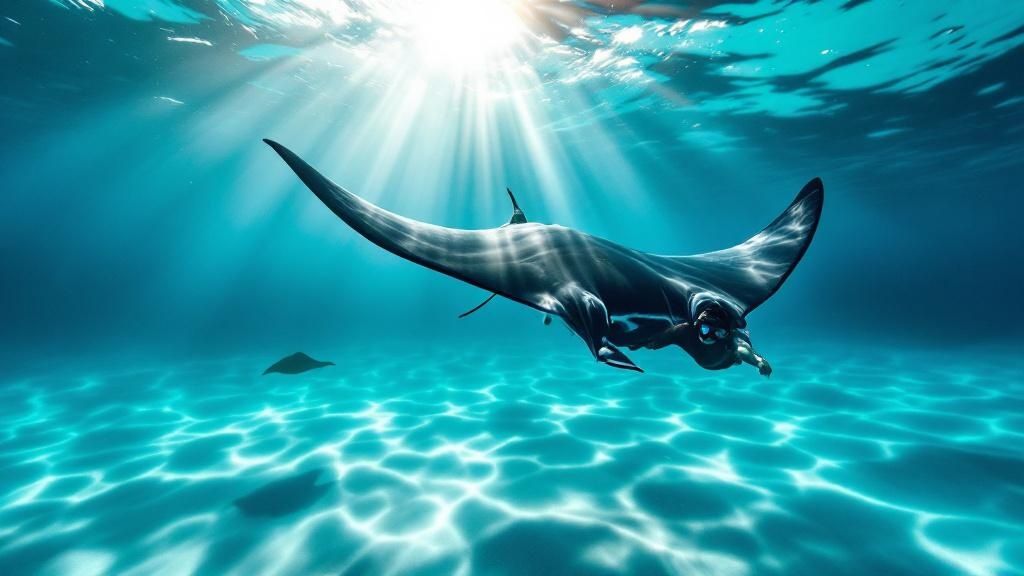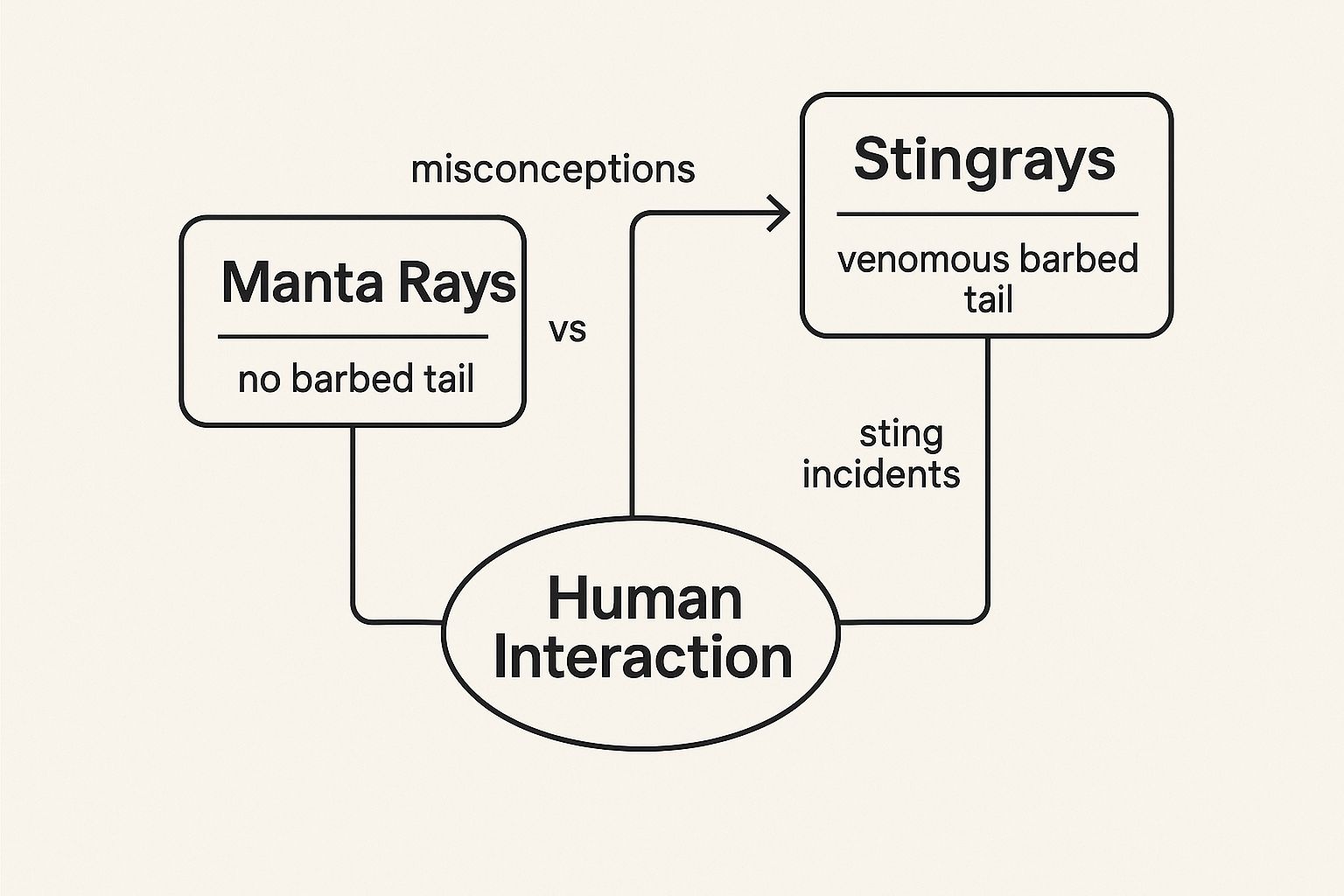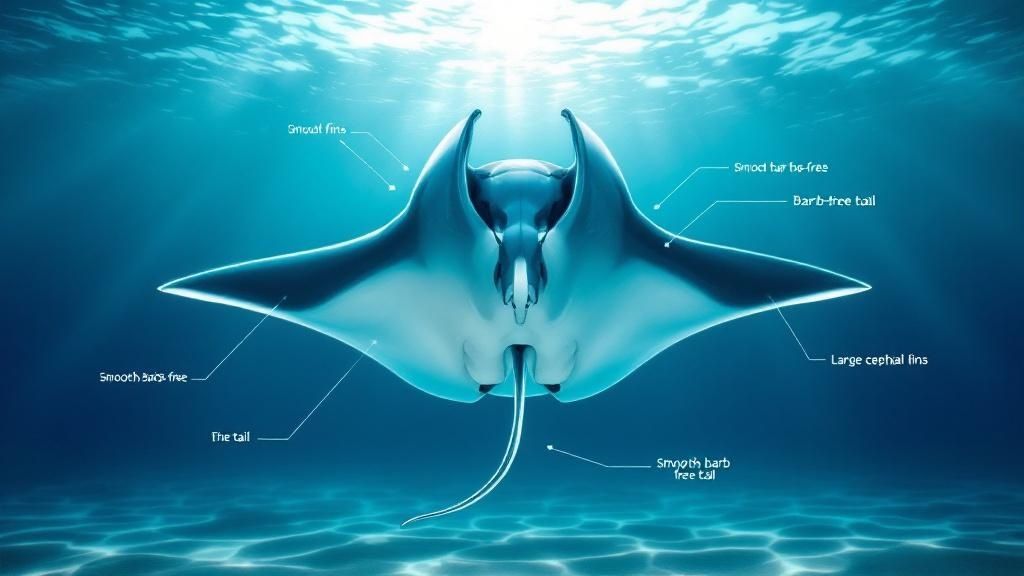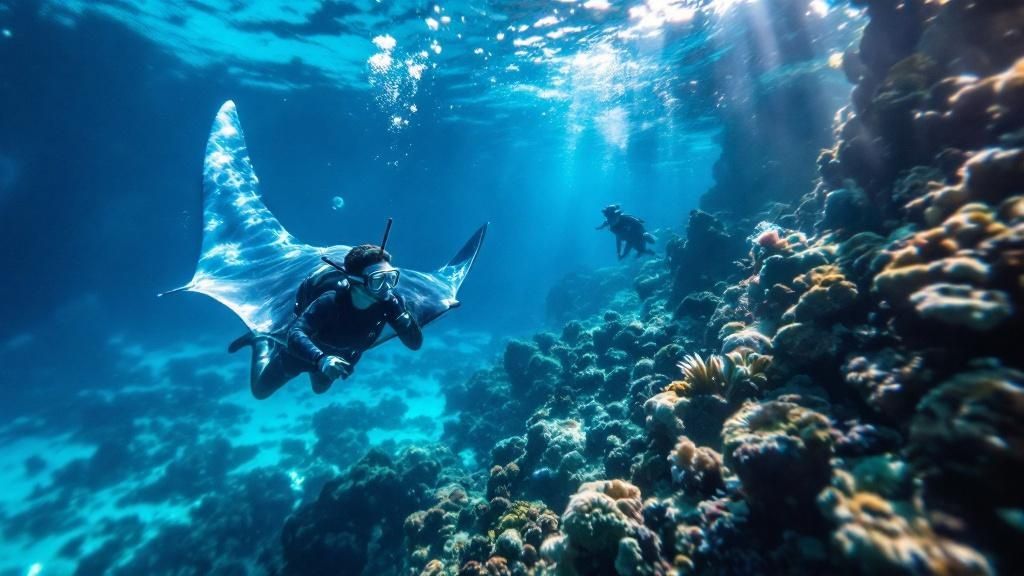Can Manta Rays Sting You? Find Out the Truth!

Let's get this out of the way right up front: No, manta rays cannot sting you. Not a chance.
It's one of the first questions we get from first-time snorkelers, and it's a completely understandable one. You see these massive, graceful creatures gliding through the water, and their resemblance to their more famous, sharp-tailed cousins—the stingrays—is hard to ignore.
The great news is that this fear is totally misplaced. Manta rays are biologically incapable of stinging. They simply don’t have the equipment for it.
So, Why Can't Manta Rays Sting You?
The confusion all comes down to their tails. A stingray uses its sharp, venomous barb as a last-resort defense mechanism. But a manta ray’s tail is a completely different tool.
Think of it less like a weapon and more like a rudder on a ship. It’s a simple, whip-like appendage they use for steering as they navigate the open ocean. There’s no stinger, no barb, and no venom. This single anatomical difference is why sharing the water with these gentle giants is always such a safe and magical experience.
Manta Ray vs. Stingray: Spotting the Difference
While they're related, mantas and stingrays have completely different lifestyles, which explains their different approaches to survival.
- Stingrays are primarily bottom-dwellers. You'll often find them buried in the sand, which is why they have a defensive barb—to protect themselves when they feel threatened, like when someone accidentally steps on them.
- Manta Rays are filter feeders that cruise the open ocean. They don't need a stinger because their defense strategy is simply their incredible size and speed. If a predator like a large shark comes along, a manta ray just swims away.
This image really helps clear things up, showing the key distinctions between these two incredible animals.

As you can see, the most important takeaway is that manta rays completely lack a stinging mechanism. This isn't just tour guide talk; it's a scientific fact. There has never been a recorded incident of a manta ray stinging a person, which has solidified their reputation as the ocean's gentle giants. We’ll dive even deeper into the topic of can manta rays sting you as we go.
To make it even clearer, here's a quick comparison to help you tell them apart next time you're near the water.
Manta Ray vs. Stingray At a Glance
| Feature | Manta Ray | Stingray |
|---|---|---|
| Tail | Long, whip-like without a barb | Shorter, thicker with a venomous barb |
| Mouth | Wide, forward-facing for filter-feeding | On the underside for eating bottom-dwellers |
| Size | Very large, up to 29 feet wide | Varies, but generally smaller |
| Diet | Plankton and krill | Crustaceans, mollusks, and small fish |
| Behavior | Swims in the open ocean | Rests on the seafloor, often buried |
| Defense | Flees using speed | Uses its venomous stinger |
So, next time someone asks if manta rays are dangerous, you'll know exactly what to tell them. These magnificent animals are all grace and no sting.
Exploring Manta Ray Anatomy: Why They Are Harmless

So, you know for a fact that manta rays can't sting you. But let's get into the why behind their famously gentle nature. The answer is all in their anatomy, which is perfectly tuned for a life of cruising the open ocean, not for picking fights. Once you understand how they're built, you’ll see exactly why they pose zero threat to people.
The most important feature to look at is the tail. Unlike its infamous cousin, the stingray, a manta ray's tail is completely harmless. Think of it less like a weapon and more like a rudder on a ship. It’s a simple, whip-like tail that might help a bit with steering, but it has no defensive purpose whatsoever.
Here's the bottom line: A manta ray’s tail completely lacks a stinger, barb, or any kind of venom-producing gland. This single anatomical fact is the reason they are physically incapable of stinging.
Their defense strategy relies on entirely different traits. Instead of fighting, a manta ray's go-to survival tools are its massive size and incredible speed. When a big shark shows up, a manta's instinct isn't to attack, but to bolt, using its powerful wings to glide swiftly out of harm's way.
Built for Filtering, Not Fighting
Another piece of the puzzle is the manta ray’s mouth. Sure, it can look intimidatingly large, but it’s engineered for a very specific job that has absolutely nothing to do with biting.
Manta rays are filter feeders. This means their diet is made up of tiny organisms like zooplankton. Their enormous mouths are designed to swallow huge volumes of water, which then flows over special plates that filter out their microscopic meals.
Here’s a quick look at their harmless design:
- Toothless Grin: Manta rays have about 300 rows of tiny, pinhead-sized teeth on their lower jaw, but they aren’t used for biting or chewing. In fact, they serve almost no real function in feeding.
- Cephalic Lobes: Those two distinctive fins on the front of their head are called cephalic lobes. When it's feeding time, they unroll them to act like funnels, directing plankton-rich water right into their mouths as they swim.
- Open-Ocean Cruisers: Mantas spend their lives in constant motion, "flying" through the water. They don't hide on the seafloor where a defensive barb might actually come in handy.
When you put it all together—a sting-free tail and a toothless, filter-feeding mouth—it’s clear why these animals are so gentle. Every part of their biology points to a creature built for grace, not aggression.
The Classic Stingray vs. Manta Ray Mix-Up
Let's get straight to it. The number one reason people ask if manta rays can sting you boils down to a classic case of mistaken identity. It's an easy mistake to make! Both mantas and stingrays have that same flattened, "sea pancake" look. But that's where the similarities end.
Their lifestyles, what they eat, and how they defend themselves are worlds apart. Once you get a feel for these differences, it becomes crystal clear why one is a cautious bottom-dweller and the other is a gentle giant of the open ocean.
Think about a stingray's daily life. It's all about the seafloor. They spend their time digging for food or burying themselves in the sand to hide from predators, with just their eyes poking out. This is exactly why they have a weapon. That sharp, venomous barb on their tail is a purely defensive tool, a last resort for when they feel trapped or—as happens far too often—when someone accidentally steps on them.
Manta rays, on the other hand, live a completely different life. They are perpetual motion machines, gliding gracefully through the vast, blue ocean. You'll never see one hiding in the sand. Their entire survival strategy is built around their incredible size and speed, not a hidden stinger.
Two Rays, Two Totally Different Lifestyles
This huge difference in where they live and what they do has shaped everything about them, from their bodies to their behavior. It’s like comparing a badger that digs and defends its burrow to a deer that roams open fields. Both are mammals, but they're built for completely different worlds.
Here’s a simple breakdown:
- Stingrays are ambush hunters on the seafloor. Their mouths are on their underside, perfectly placed to slurp up crabs, clams, and small fish they find in the sand. That defensive barb is crucial for a life spent on the ground.
- Manta rays are open-ocean filter-feeders. Their huge, forward-facing mouths are designed to swallow massive amounts of water, filtering out the tiny plankton they live on. They have absolutely no need for a stinger because their best defense is to simply swim away.
This is the key distinction when it comes to any human interaction. The vast majority of ray-related injuries worldwide come from stingrays. While stingrays are responsible for thousands of defensive stings every year, fatalities are incredibly rare.
In stark contrast, there are zero recorded instances of a manta ray ever stinging or causing a fatality. This fact alone cements their reputation as harmless, gentle giants. If you're curious to learn more about ray injuries and why even stingrays aren't out to get you, check out the great insights on downtoearth.org.in.
By understanding their different roles in the ocean, you can easily tell them apart and know that seeing a manta ray is a reason for excitement, not fear.
The Real Dangers Manta Rays Face in the Ocean

So, we've settled the big question: can a manta ray sting you? The answer is a firm no. But that conversation feels a little one-sided, doesn't it? It's time we flip the script.
Instead of us worrying about them, we need to recognize that they’re the ones facing real, constant threats. In the vast blue expanse they call home, these gentle giants are up against some serious dangers, from both natural predators and, unfortunately, us.
Even with their massive size, manta rays aren't at the top of the food chain. They have to watch out for some of the ocean's most skilled hunters, especially big sharks like tiger sharks and great hammerheads. These predators often strike from below, taking huge bites out of the manta's wing-like pectoral fins. You can often see the evidence of these battles etched into their bodies as permanent scars.
But the most heartbreaking dangers? Those come from human activity.
The Human Impact on Manta Ray Survival
Unlike a clean bite from a shark—which a manta can often survive—injuries from human encounters are frequently slow, agonizing, and deadly. These threats are the number one reason their populations are declining around the world.
The main culprits are things we leave behind or don't manage properly:
- Fishing Gear Entanglement: Manta rays are constantly getting tangled up in discarded fishing lines, nets, and mooring ropes. These "ghost nets" are a nightmare. They wrap around their bodies, slicing into their skin, preventing them from feeding, and making it impossible to escape from predators.
- Boat Strikes: In busy channels and popular tourist spots, mantas often swim near the surface. A collision with a fast-moving boat hull or propeller can cause horrific, life-ending injuries.
- Overfishing and Bycatch: While not always the intended target, countless mantas are accidentally caught as bycatch in massive commercial fishing operations.
The scale of this is staggering. For instance, studies in heavily trafficked areas like southern Mozambique show that while 68-76% of manta rays bear scars from shark bites, the dangers from human-caused injuries add another devastating layer. You can learn more about the challenges manta rays face from research findings.
When you understand what they're really up against, it completely changes how you see them. Manta rays aren't a threat to us. They are a beautiful, vulnerable species that desperately needs our respect and protection.
How to Safely and Respectfully Swim with Manta Rays

Sharing the water with a manta ray is an absolutely breathtaking experience, but it’s a privilege that comes with real responsibility. Now that we know the answer to "can manta rays sting you?" is a definite no, the focus shifts entirely to their safety and comfort—not ours. Following a simple code of conduct ensures these gentle giants stay safe and that you get the most authentic, memorable interaction possible.
The golden rule is simple: look, but don't touch. It's so important. A manta ray's skin is covered in a protective mucus layer, which is its first line of defense against nasty infections. Touching them, even gently, can strip this coating away and leave them vulnerable to disease. Just think of it as accidentally wiping away a shield they desperately need to survive in the ocean.
How you approach them is just as crucial. You should never chase a manta ray or swim directly over or under them, as this can easily make them feel trapped and stressed. The best way is to approach calmly from the side, giving them tons of space to move around freely. If you're planning your own encounter, you can find more great tips in this guide to the ultimate manta ray snorkel experience in Kona.
The Cardinal Rules of Manta Encounters
To make sure it’s a positive experience for both you and the mantas, you have to follow a few key guidelines. Any reputable tour operator will brief you on these rules, but it’s always best to know them by heart before you even get on the boat.
- Maintain a Respectful Distance: Always try to stay at least 10 feet (3 meters) away. If a curious manta decides to swim closer to check you out, just stay still and let it pass.
- No Chasing or Riding: This should be obvious, but never, ever attempt to chase, grab, or "ride" a manta ray. It’s incredibly stressful for the animal and is illegal in many places, including Hawaii.
- Keep Splashing to a Minimum: Try to move slowly and deliberately in the water. Loud noises and a lot of splashing can easily startle these gentle creatures, causing them to bolt.
The goal of any wildlife encounter is to be a passive observer. When you stay calm and respectful, you allow the mantas to behave naturally. This often results in them getting curious, coming closer, and staying around much longer.
Following these steps doesn't just protect the animals; it dramatically improves your own experience. For a complete rundown of what to expect on a tour, check out our detailed guide on swimming with manta rays.
Still Curious? Let's Talk Manta Behavior
Even after learning that the answer to "can manta rays sting you?" is a big, resounding "no," you probably still have a few questions buzzing around. It's only natural. When you see these huge, graceful animals, their sheer size and unique looks spark a ton of curiosity. Let's clear up some of the most common questions to round out your manta knowledge.
Think of this as a quick chat to tackle those lingering thoughts and make sure you're feeling totally confident about these gentle giants.
If Its Tail Isn't for Stinging, What's It For?
That's a fantastic question, and it gets right to the heart of what makes a manta a manta. Honestly? Their tail is pretty much just an evolutionary leftover. It's a short, whip-like thing without a single stinger or barb on it, making it completely useless for defense.
It’s kind of like the human appendix—a relic from a distant ancestor that doesn't really do anything anymore. Instead of fighting, a manta ray uses its massive size and incredible speed to simply out-swim and escape predators like big sharks. The tail is just along for the ride.
Are Manta Rays Aggressive Towards Humans?
Absolutely not. Manta rays are famous for being gentle giants, often showing more curiosity than anything else. They have zero reason—and zero ability—to be aggressive toward people.
They're filter feeders, so their mouths are built for gulping down tiny plankton, not for biting. They do have about 300 rows of tiny, pin-prick-sized teeth, but they're not functional and pose no threat whatsoever. Any story you hear about a manta "attack" is almost always a simple misunderstanding, usually just an accidental bump in the water. As long as swimmers are respectful, these encounters stay peaceful and magical.
Key Takeaway: Manta rays are not dangerous. Their calm, curious nature is exactly why swimming with them is such a popular and safe activity all over the world.
What's the Difference Between a Manta Ray and a Devil Ray?
This is a really common mix-up! It's easy to see why—manta rays and devil rays are super close cousins in the Mobulidae family and look a lot alike. In fact, scientists recently reclassified them into the same genus, Mobula, because they're so similar.
But if you know what to look for, you can spot the differences:
- Size: This is the easiest giveaway. Manta rays are way bigger. Giant oceanic mantas can have a "wingspan" of over 20 feet, while the biggest devil rays usually max out around 11 feet.
- Mouth Placement: Take a look at the head. A manta ray's mouth is terminal, meaning it's right at the front of its body. A devil ray's mouth is subterminal—it's on the underside, more like a stingray's.
- Cephalic Fins: Both use these fins to funnel plankton-rich water into their mouths. On a manta, these "horns" are usually pretty loose and relaxed. On a devil ray, they often look more tightly curled.
Despite these little differences, the most important thing they have in common is that neither mantas nor devil rays have stingers. Both are completely harmless filter feeders. If you want to dive even deeper, our full guide covering more frequently asked questions about manta rays is a great place to start.
Ready to witness these gentle giants in person? Kona Snorkel Trips offers the highest-rated and most unforgettable manta ray night snorkel on the Big Island. Join our lifeguard-certified guides for a safe, small-group adventure you'll cherish forever. Book your tour at https://konasnorkeltrips.com.
